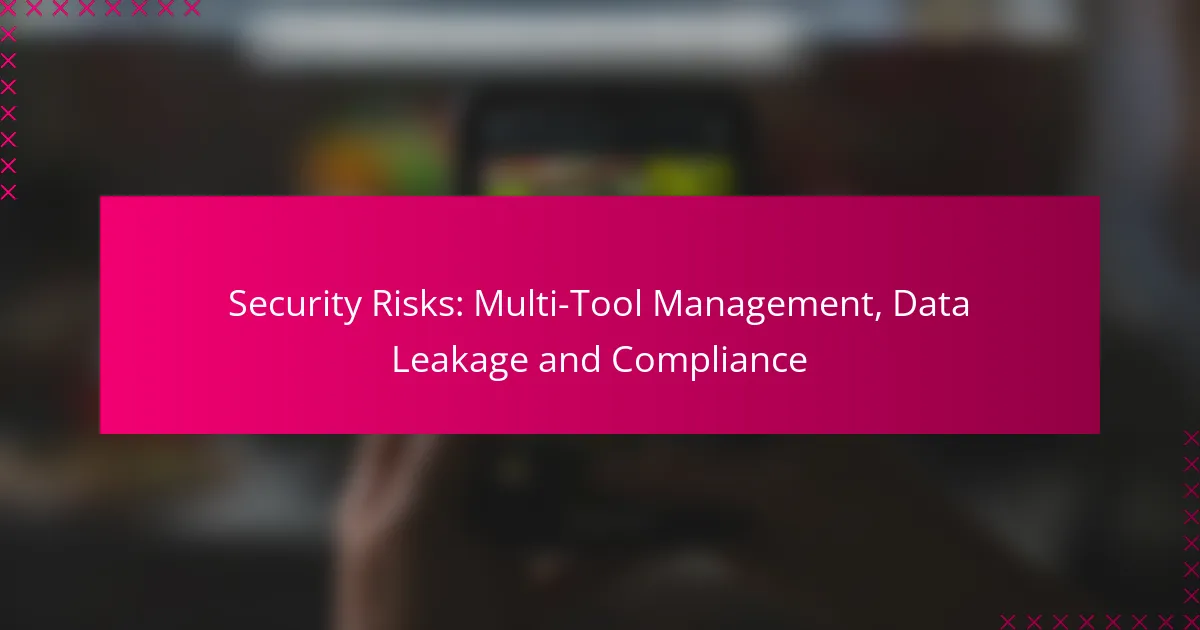In today’s digital landscape, multi-tool management presents significant security risks for organizations, including vulnerabilities and compliance challenges. The complexity of overseeing various tools can lead to data fragmentation and gaps in security protocols. To safeguard sensitive information and ensure adherence to regulations like GDPR, organizations must implement robust security measures and regular assessments.
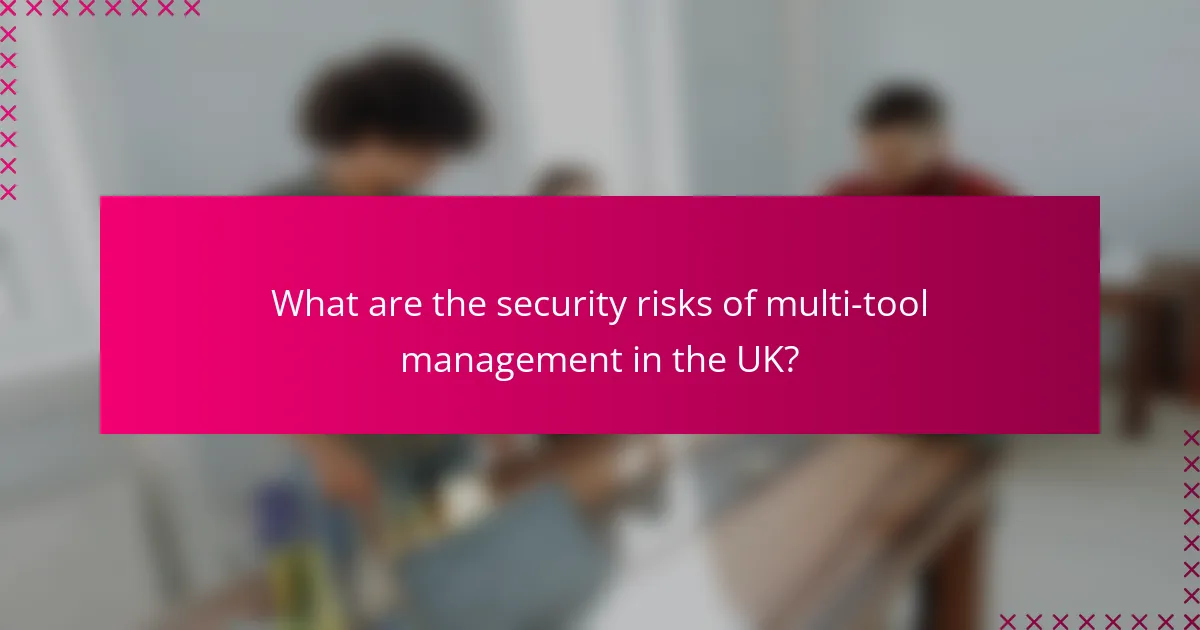
What are the security risks of multi-tool management in the UK?
Multi-tool management in the UK can expose organizations to various security risks, including increased vulnerabilities, data fragmentation, and compliance challenges. The complexity of managing multiple tools can lead to gaps in security protocols and oversight.
Increased attack surface
Using multiple tools increases the attack surface, making it easier for cybercriminals to exploit vulnerabilities. Each tool may have its own security flaws, and when combined, they create more entry points for potential attacks.
Organizations should regularly assess the security of each tool and implement robust access controls. Conducting penetration testing can help identify weaknesses before they are exploited.
Data fragmentation
Data fragmentation occurs when information is spread across various tools, making it difficult to maintain a cohesive security strategy. This fragmentation can lead to inconsistent data protection measures and increased risk of data breaches.
To mitigate this risk, organizations should centralize data management where possible. Utilizing integrated platforms can help streamline data handling and enhance security protocols.
Compliance challenges
Managing multiple tools can complicate compliance with regulations such as the General Data Protection Regulation (GDPR) in the UK. Each tool may have different compliance requirements, leading to potential oversights.
Organizations must ensure that all tools are compliant with relevant regulations. Regular audits and compliance checks can help identify areas of concern and ensure that all tools meet necessary legal standards.
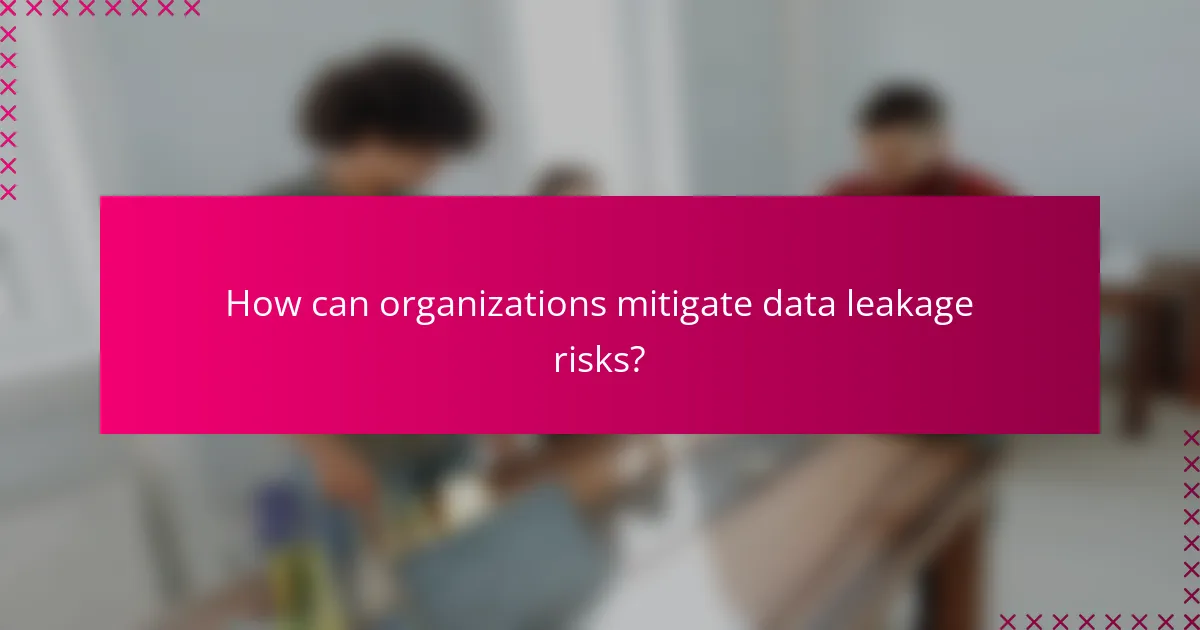
How can organizations mitigate data leakage risks?
Organizations can mitigate data leakage risks by implementing robust security measures, including technology solutions, regular assessments, and employee training. These strategies help protect sensitive information from unauthorized access and ensure compliance with relevant regulations.
Implement data loss prevention (DLP) tools
Data Loss Prevention (DLP) tools are essential for identifying and protecting sensitive data across various platforms. These tools monitor data in use, in motion, and at rest, preventing unauthorized sharing or access. Organizations should choose DLP solutions that integrate seamlessly with existing systems and offer customizable policies to fit specific needs.
Consider using DLP tools that provide real-time alerts and reporting features. This allows organizations to respond quickly to potential breaches. Regularly updating DLP policies based on evolving threats and business changes is crucial for maintaining effectiveness.
Conduct regular security audits
Regular security audits help organizations identify vulnerabilities and assess the effectiveness of their data protection measures. These audits should include a comprehensive review of systems, processes, and compliance with industry standards such as GDPR or HIPAA. Engaging third-party experts can provide an unbiased assessment and uncover blind spots.
Establish a routine for conducting audits, such as quarterly or biannually, to ensure continuous improvement. Document findings and create action plans to address any identified weaknesses, prioritizing high-risk areas for immediate attention.
Train employees on data handling
Employee training is vital for preventing data leakage, as human error is often a significant factor in breaches. Organizations should implement regular training sessions that cover best practices for data handling, including recognizing phishing attempts and securely sharing information. Tailoring training to specific roles can enhance its relevance and effectiveness.
Consider using interactive training methods, such as simulations and quizzes, to engage employees and reinforce learning. Regularly updating training materials to reflect new threats and technologies ensures that employees remain informed and vigilant against potential risks.

What compliance requirements affect multi-tool management?
Multi-tool management is influenced by various compliance requirements that ensure data protection and privacy. Organizations must adhere to regulations like GDPR and the Data Protection Act 2018 to mitigate risks associated with data leakage and maintain compliance across multiple tools.
GDPR regulations
The General Data Protection Regulation (GDPR) mandates strict guidelines for data handling, affecting how organizations manage multiple tools. Companies must ensure that any tool used for processing personal data complies with GDPR principles, including data minimization, purpose limitation, and ensuring data subject rights.
To comply, organizations should conduct regular audits of their tools, ensuring that data is processed lawfully and transparently. Implementing data protection by design and default is crucial, meaning that privacy measures should be integrated into the tools from the outset.
Data Protection Act 2018
The Data Protection Act 2018 complements GDPR in the UK, establishing additional requirements for data processing. It emphasizes the importance of accountability and transparency, requiring organizations to document their data processing activities and maintain records of consent.
Organizations must assess how their multi-tool management practices align with the principles outlined in this Act. Regular training for employees on data protection obligations and the implementation of clear data handling policies can help mitigate compliance risks.
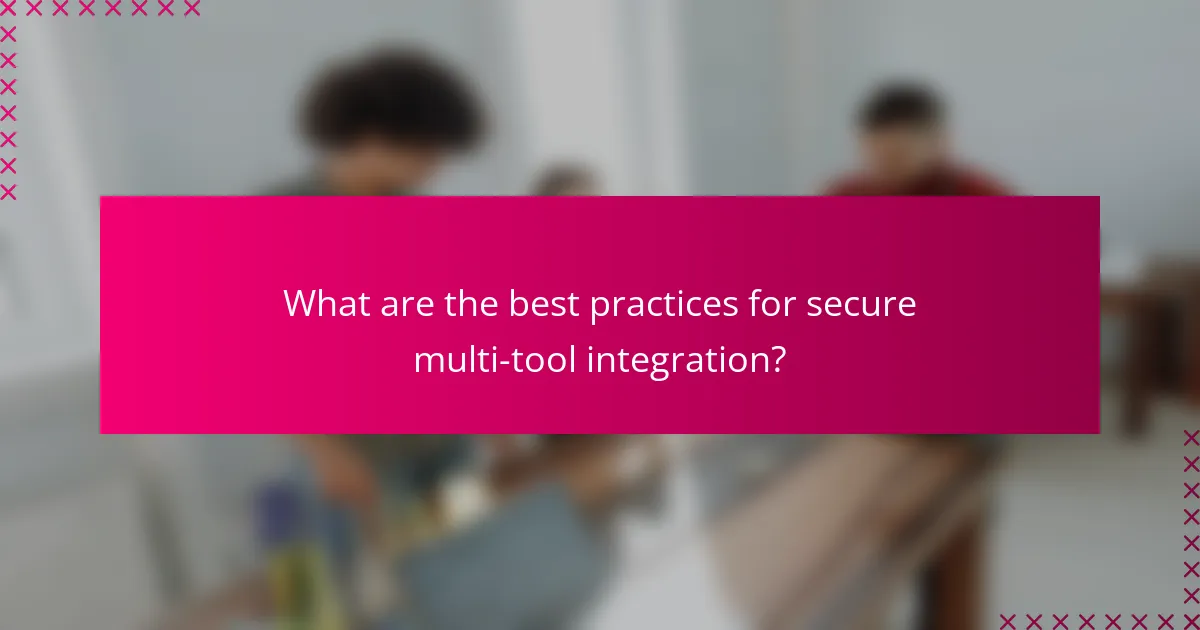
What are the best practices for secure multi-tool integration?
Secure multi-tool integration involves implementing strategies that protect data and ensure compliance across various platforms. By following best practices, organizations can mitigate risks associated with data leakage and maintain robust security protocols.
Use API security measures
Implementing API security measures is crucial for protecting data exchanged between tools. This includes using authentication protocols like OAuth and ensuring that all API calls are encrypted using HTTPS to prevent unauthorized access.
Additionally, consider rate limiting and IP whitelisting to control access and reduce the risk of abuse. Regularly auditing API endpoints for vulnerabilities can help identify and rectify potential security gaps.
Establish access controls
Establishing access controls is essential for limiting who can interact with your tools and data. Role-based access control (RBAC) allows you to assign permissions based on user roles, ensuring that individuals only have access to the information necessary for their tasks.
Regularly review and update access permissions to reflect changes in team structure or project requirements. Implementing multi-factor authentication (MFA) adds an extra layer of security by requiring users to verify their identity through multiple methods.
Regularly update software
Regularly updating software is a fundamental practice for maintaining security in multi-tool environments. Software updates often include patches for known vulnerabilities, which can help protect against potential exploits.
Establish a routine schedule for checking and applying updates, and consider using automated tools to streamline the process. Ensure that all integrated tools are compatible with the latest versions to avoid conflicts that could lead to security risks.

How do organizations choose the right tools for compliance?
Organizations select compliance tools by evaluating their specific regulatory needs, the tools’ capabilities, and how well they integrate with existing systems. A thorough assessment ensures that the chosen tools not only meet compliance requirements but also enhance overall security and efficiency.
Evaluate tool compatibility
Compatibility with existing systems is crucial when selecting compliance tools. Organizations should assess how well new tools integrate with current software, databases, and workflows to avoid disruptions and ensure seamless operations.
Consider conducting a compatibility audit that includes testing integrations in a controlled environment. This can help identify potential conflicts and ensure that the tools can work together effectively.
Assess vendor security certifications
Vendor security certifications provide assurance that compliance tools meet industry standards for data protection and security. Look for certifications such as ISO 27001, SOC 2, or GDPR compliance, which indicate a commitment to maintaining high security standards.
When evaluating vendors, request documentation of their certifications and review their security practices. This due diligence helps mitigate risks associated with data leakage and ensures that the vendor adheres to relevant compliance regulations.
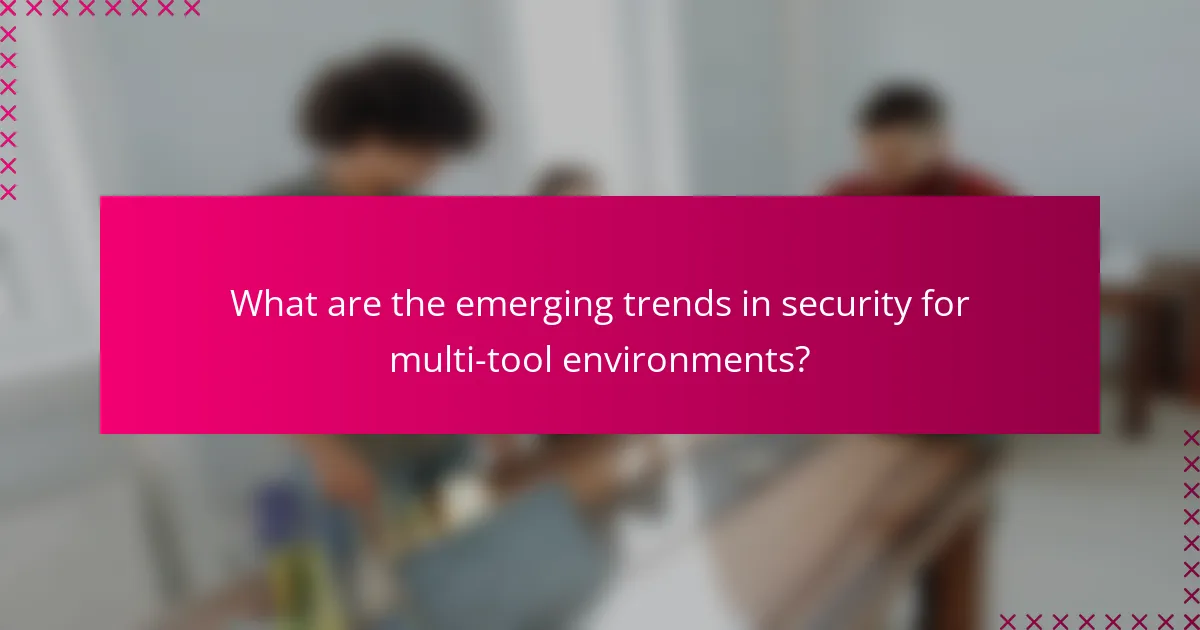
What are the emerging trends in security for multi-tool environments?
Emerging trends in security for multi-tool environments focus on enhancing threat detection, implementing zero-trust models, and integrating privacy by design principles. These trends aim to mitigate risks associated with data leakage and ensure compliance across various platforms.
Increased use of AI for threat detection
The integration of artificial intelligence (AI) in threat detection is revolutionizing security measures in multi-tool environments. AI algorithms can analyze vast amounts of data in real-time, identifying anomalies and potential threats much faster than traditional methods.
Organizations should consider deploying AI-driven security tools that continuously learn from new data patterns. This proactive approach can significantly reduce response times to incidents, often bringing them down to mere minutes.
Adoption of zero-trust security models
Zero-trust security models operate on the principle of “never trust, always verify,” meaning that every access request is treated as a potential threat. This model is particularly effective in multi-tool environments where data flows between various applications and services.
To implement a zero-trust model, organizations should focus on strict identity verification, continuous monitoring, and limiting access based on user roles. This can involve using multi-factor authentication (MFA) and regularly updating access permissions to minimize risks.
Integration of privacy by design principles
Privacy by design emphasizes the importance of incorporating privacy measures into the development of tools and processes from the outset. This proactive approach helps organizations address compliance requirements and mitigate data leakage risks effectively.
When adopting privacy by design, organizations should conduct regular privacy impact assessments and involve stakeholders in the design process. This ensures that privacy considerations are embedded into every aspect of tool management, reducing the likelihood of breaches and enhancing user trust.
